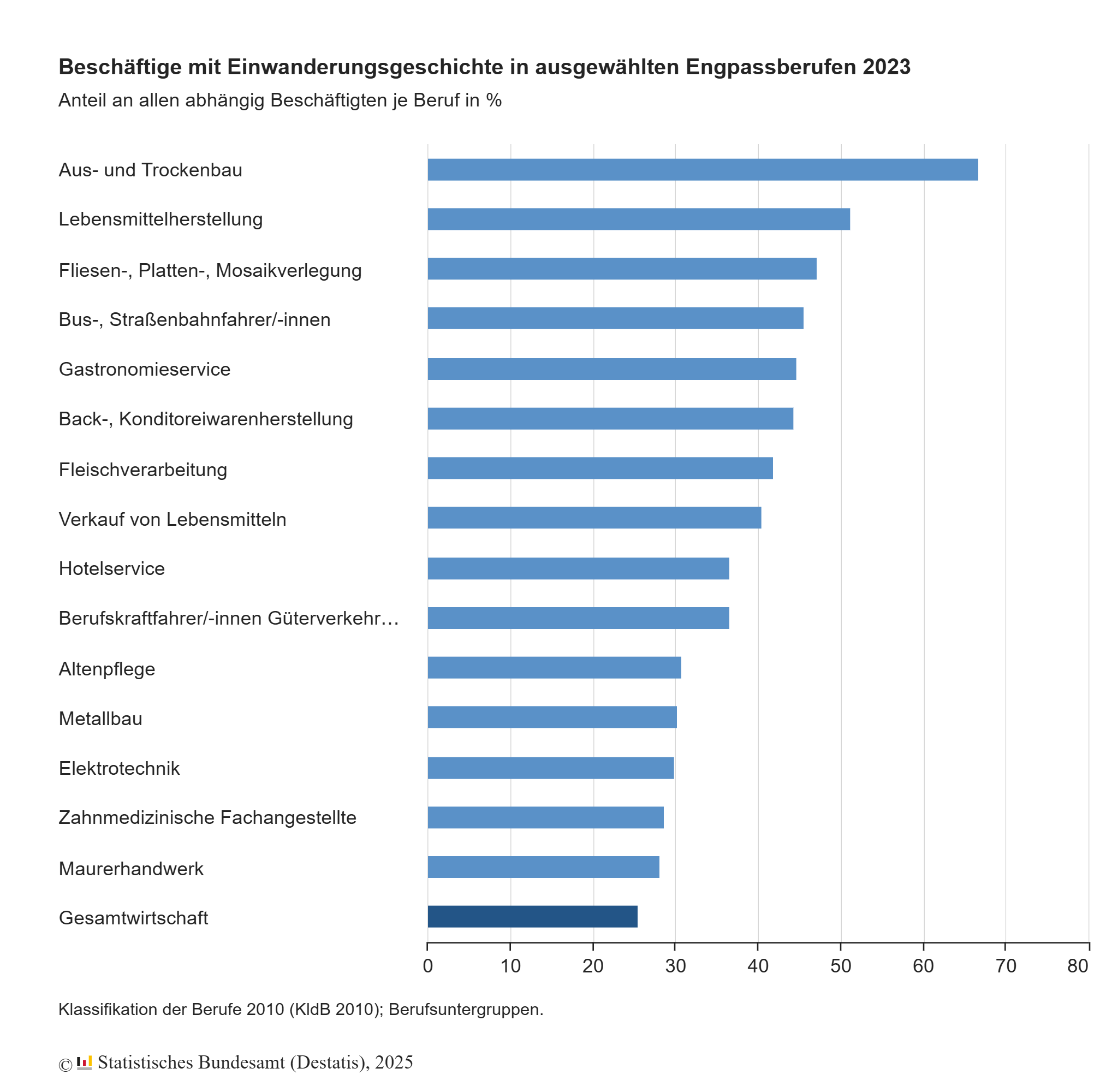A few years ago, there was already a study on the fact that migration can be an engine for economic recovery. Germany’s Federal Statistical Office, Destatis, has now once again published results from the microcensus that speak a similar language.
Wiesbaden/Germany, February 27, 2025 Whether in construction, the food industry, catering, care or passenger and freight transport, employees with a history of immigration are represented to an above-average extent in many bottleneck occupations. For example, two out of three (67%) employees in finishing and drywall construction in 2023 had a history of immigration, as reported by the Federal Statistical Office (Destatis) based on the results of the microcensus. In food production, this applied to more than half of employees (51%). The proportion was also above average in the occupation group of tilers (47%), among bus and tram drivers (46%) and among service staff in the catering industry (45%). In the economy as a whole, a good quarter (26%) of all employees had a history of immigration, i.e. had themselves immigrated to Germany since 1950 or both parents had immigrated since then. According to the Federal Employment Agency’s (BA) bottleneck analysis, there is or is likely to be a shortage of skilled labour in so-called bottleneck occupations.
Almost a third of employees in geriatric care have a history of immigration
The proportion of employees with a history of immigration is also significantly higher than the overall economic average in other shortage occupations, such as meat processing (42%), food sales (41%), professional drivers in freight transport (37%), geriatric care (31%), metal construction and electrical engineering (both 30%).
The bottleneck occupation with the lowest proportion of employees with a history of immigration was insurance salespersons (13 %). Even if the following are not shortage occupations according to the BA’s shortage analysis, people with a history of immigration are even more underrepresented in some occupational groups: This is particularly true of the police enforcement service (6 %), public administration occupations (9 %), teachers (primary level: 9 %, secondary level: 11 %) and commercial and technical business administration (12 %).
Sectors: Catering and building services have the highest proportion of employees with a history of immigration
It is not only in many shortage occupations that the proportion of people with a history of immigration is high. Some sectors are particularly reliant on workers who have immigrated themselves or whose parents have both immigrated. This is particularly the case in catering – followed by building services, warehousing and other transport services. In 2023, more than half (54%) of all employees in the catering industry had a history of immigration, regardless of their occupation. In building services, which largely consists of building cleaning but also includes gardening and landscaping, just under half (49%) of employees had a history of immigration. In warehousing and other transport services, the figure was 41%.
An above-average proportion of employees with a history of immigration also worked in postal, courier and express services and in the accommodation sector (40% each). In motor vehicle production (31%) and in retirement and nursing homes and similar facilities (30%), both of which are high employment sectors with more than one million employees each, the proportion was also well above the average for the economy as a whole (26%).
In contrast, people with a history of immigration were significantly underrepresented in public administration, defence and social security (10 %), insurance (13 %), energy supply (14 %), financial services (15 %) and education (17 %) in 2023.
Methodological notes:
The information on dependent employees comes from the initial results of the 2023 microcensus, which is a sample survey in which around 1% of the population in Germany is interviewed each year. In order to be able to make statements about the total population from the data collected, the data is extrapolated using the key figures of the population extrapolation. The extrapolation is based on the population update based on the 2011 census. Results of the microcensus extrapolated on the basis of the 2022 census are expected to be available at the end of May 2025. All information is based on self-reporting by respondents.
A person has an immigration history if they themselves or both parents have immigrated to Germany since 1950. The results relate to the population in private main residence households aged 15 and over. The population in shared accommodation (e.g. refugees living there) is not included in the results.
Further information:
The Federal Statistical Office bundles data and facts on the topic of skilled labour on a special page: destatis.de/fachkraefte. The data available covers the areas of demography, employment, education and immigration. It ranges from projections on the future number of people in employment to analyses of the labour supply and data on labour migration and the training market.
The Integration dashboard provides further information on the integration of people with a history of immigration. The Integration Dashboard provides interactive graphics on all 60 indicators of the 14th Integration Report of the Federal Government Commissioner for Migration, Refugees and Integration. The broad range of data covers 14 subject areas, including the labour market, education, demographics, social and societal participation and security.
ImageSource
Destatis, Beschaeftigte Einwanderungsgeschichte Berufe


